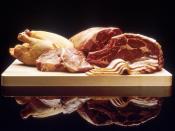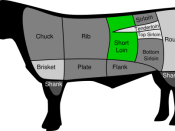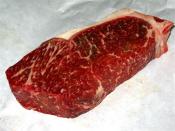Beef The domestication of cattle for food dates to about 6500 B.C. in the Middle East. Cattle were not native to America, but brought to the New World on ships by European colonists. Americans weren't big eaters of fresh beef until about 1870, due to the enormous growth of the cattle industry in the West. The introduction of cattle cars and refrigerated cars on the railroad facilitated distribution of the beef.
"Beef" is meat from full-grown cattle about 2 years old. A live steer weighs about 1,000 pounds and yields about 450 pounds of edible meat. There are at least 50 breeds of beef cattle, but fewer than 10 make up most cattle produced. Some major breeds are Angus, Hereford, Charolais, and Brahman. "Baby beef" and "calf" are interchangeable terms used to describe young cattle weighing about 700 pounds that have been raised mainly on milk and grass. The meat cuts from baby beef are smaller, is light red and contains less fat than beef.
The fat may have a yellow tint due to the vitamin A in grass. "Veal" is meat from a calf which weighs about 150 pounds. Those that are mainly milk-fed usually are less than 3 months old. The difference between "veal" and "calf" is based on the color of their meat, which is determined almost entirely by diet. Veal is pale pink and contains more cholesterol than beef.
All beef found in retail stores is either USDA inspected for wholesomeness or inspected by state systems which have standards equal to the Federal government. Each steer and its internal organs are inspected for signs of disease. The "Passed and Inspected by USDA" seal insures the beef is wholesome and free from disease.
The first standards for grading beef were put into service in 1917. Since then,


